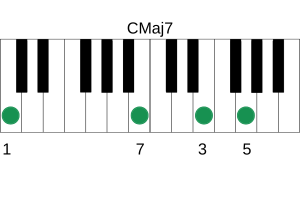 When you’re searching for that lush, expressive sound that defines cocktail piano ballads, not every voicing makes the cut. Some are too dense. Some leave too much harmonic space. And others? Just plain awkward under the fingers.
When you’re searching for that lush, expressive sound that defines cocktail piano ballads, not every voicing makes the cut. Some are too dense. Some leave too much harmonic space. And others? Just plain awkward under the fingers.
But there’s one cocktail piano voicing that checks all the boxes: 1–7–3–5.
At first glance, it may seem like more than you need. But stick with it—and you’ll discover it’s not just functional, it’s flexible, beautiful, and deeply expressive. Whether you’re backing a singer, playing solo, or gently weaving a tune through a lounge, this voicing has all the character and color a ballad could ask for.
What Is the 1–7–3–5 Voicing?
It’s clean, balanced, and elegant:
- Left Hand: Root (1) and Seventh ( 7)
- Right Hand: Third (3) and Fifth (5)
Keep in mind that this accommodates all kinds of 7th chords in so may situations, so feel free to alter those tones as necessary (b3, b7, b5, #5, etc.)
This layout offers two critical benefits:
- Root + context from the left hand—it provides the harmonic foundation.
- Clarity + flexibility in the right hand—allowing melody or variation.
In C major, a Cmaj7 voiced this way would be:
- LH: C and B
- RH: E and G (as illustrated above)
Already gorgeous—but now, let’s open the creative doors.
When the Fifth Is the Melody
Sometimes the fifth is the melody—perfect! That makes the full 1–7–3–5 voicing land effortlessly under your hands. It gives you harmonic support and melodic clarity without compromise.
Melody on the Third? Super…
If the melody is the third (E in Cmaj7), it’s already part of your right hand. You can:
- Play the voicing as-is with E on top
- Drop the 5th for more melodic space
This flexibility gives you room to respond to phrasing, singers, or just your own expressive instinct.
What About the Ninth as Melody?
Here’s where this voicing shines. If the melody is the 9th (D in Cmaj9), simply add it with your pinky on top of your right-hand chord:
- LH: C and B
- RH: E and G + D on top (this is the first voicing we talk about in ProProach, by the way!)
This turns a basic voicing into a lush extension—easily, and musically.
Freedom Through Simplicity
Many ballad textures don’t need full chords every beat. That’s why 1–7 in the left hand is often enough. You’re providing the harmonic floor—and giving your right hand the chance to phrase, decorate, or float entirely.
The beauty is that this voicing works in fragments: use it whole, spread it out arpeggiated, or break it into components. The 1–7 provides structure. The 3 and 5 offer melodic and rhythmic material to explore.
Turn It Into a Playground
Here’s a quick exercise:
- Play a ballad in slow tempo using LH 1–7 only.
- Add 3–5 in RH only where it supports the melody or tension.
- Try the full 1–7–3–5 voicing when the melody is the 5th.
- Stretch to the 9 with your pinky to color a phrase.
Repeat, reshape, and stay loose. You’ll find your phrasing becoming more intentional with less “chord stuffing.”
The Bottom Line
There’s a reason the cocktail piano voicing known as 1–7–3–5 shows up in so many great arrangements. It’s elegant, it’s expressive, and it’s built for flexibility. Whether you’re using it as a full grip or adapting on the fly, it keeps you harmonically grounded while inviting creativity up top.
This voicing is more than functional—it’s foundational. And once it’s under your fingers, you’ll find yourself returning to it again and again in slow standards, lush intros, and warm endings.
Melody on the 5th? Perfect. Melody on the 9th? Add it. Melody not written yet? This voicing helps you find it.